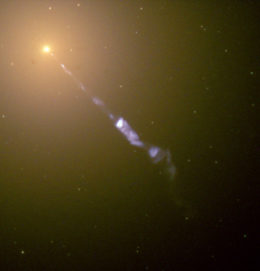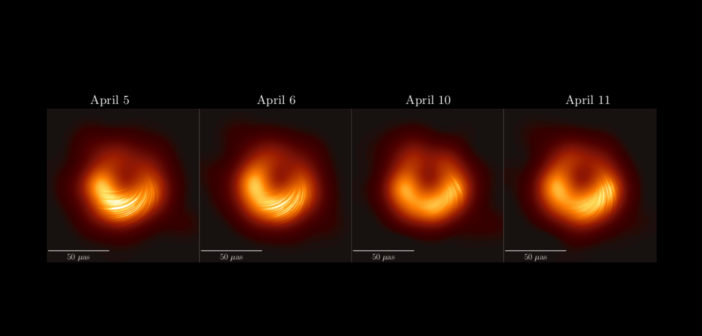Almost two years ago, the Event Horizon Telescope team grabbed the world’s attention with a stunning first picture of the inner regions around a supermassive black hole. Now the team is sharing new insight from their unprecedented observations.
A Giant Telescope’s Target

EHT observations of M87 taken over 4 days revealed a bright, asymmetric ring; north is up and east is left. [EHT Collaboration et al 2019]
Why target M87*? This black hole is relatively nearby, it’s enormous (6.5 billion solar masses!), and it doesn’t vary too quickly. What’s more, M87* is the source of a spectacular, 5,000-light-year-spanning jet.
Looking for Launch
Jets are produced when accreting material is flung out from the poles of a supermassive black hole at incredible speeds — but the means by which they are launched, accelerated, and shaped, and even how they emit light, are all still open questions.
Could M87 help us to better understand these dramatic phenomena? The EHT team has now released two exciting new publications that provide additional insight into the environment close around M87*, from which its jet originates.

M87’s supermassive black hole produces a collimated jet, visible in this Hubble image. Its counter-jet isn’t seen because relativistic effects make the receding jet appear less bright. [The Hubble Heritage Team (STScI/AURA) and NASA/ESA]
An Added Dimension
When the EHT observed M87* in 2017, it didn’t just capture the data that led to the total intensity images we’ve all seen; it also captured information about the polarization of the light observed.
When light is emitted from hot, magnetized plasma, it is linearly polarized — the magnetic field leaves an imprint on the direction the electromagnetic waves oscillate. As the light travels, this polarization can then rotate or become scrambled as it moves through magnetized matter.
The direction and amount of polarization that we ultimately observe from a source like M87* — if properly disentangled and analyzed — reveals information about the structure of the magnetic fields and the plasma properties close around this black hole.
What We Found and What It Means

Polarization maps of M87* captured by the EHT on 4 different days. The ticks show the polarization direction and fraction. [EHT Collaboration et al. 2021]
- The emission ring around the black hole exhibits polarization, but the polarization fraction is relatively low.
This confirms the picture of a hot, magnetized plasma in the inner regions around the black hole, and it indicates that the polarization is scrambled inside the emission region, on scales smaller than the telescope can resolve. - Across the 4 different observations spanning roughly a week, the polarization evolves.
These changes over time are expected, and while the team doesn’t analyze it here, this evolution will likely help us to further constrain models in the future. - In all observations, the polarization pattern is largely azimuthal, wrapping around the black hole.
This is important: this directionality places significant limits which models can feasibly describe the structure of the magnetic fields and the accretion flow immediately around the black hole.
A MAD Flow?
The authors compare the observed polarization maps for M87* to a gallery of 72,000 snapshot images from numerical simulations probing 120 different models of the accretion flow and jet. The tight constraints from the EHT’s intensity and polarization observations dramatically reduce the set of feasible models, suggesting that the surroundings of M87* are best described by a model called a magnetically arrested disk (MAD).

Schematic illustrating the MAD model, as viewed from within the plane of the accretion disk around a black hole. Poloidal magnetic field lines pile up close to the black hole, pushing back on the infalling matter. [Narayan et al. 2003]
With possible models in hand, the authors conclude by using them to estimate the properties of the plasma around M87* and the accretion rate onto this supermassive black hole — finding it’s likely accreting around a Jupiter mass each year.
Looking to the Future
It’s clear that there’s still a lot we can learn from the EHT’s first observations — and with follow-up observations and analysis, we can continue to use M87* as a laboratory for exploring supermassive black holes and their accretion flows and jets.
What’s more, we know the EHT is still working to create images of our own supermassive black hole at the center of the Milky Way, Sgr A*. If successful, this endeavor will provide complementary insight into a somewhat quieter supermassive black hole. EHT continues to brighten our outlook on black holes!
For more information, you can see the complete collection of EHT results in the ApJL focus issue:
Focus on the First Event Horizon Telescope Results
Citation
“First M87 Event Horizon Telescope Results VII: Polarization of the Ring,” EHT Collaboration et al 2021 ApJL 910 L12. doi:10.3847/2041-8213/abe71d
“First M87 Event Horizon Telescope Results VIII: Magnetic Field Structure Near the Event Horizon,” EHT Collaboration et al 2021 ApJL 910 L13. doi:10.3847/2041-8213/abe4de

8 Comments
Pingback: M87s Central Black Hole in Polarized Light - Automat
Pingback: M87s Central Black Hole in Polarized Light
Pingback: M87s Central Black Hole in Polarized Light > Dr. Farzin Rejaifar Website
Pingback: The Cosmos with M87's Black Hole · mick laBriola
Pingback: Marzo 31, 2021. El Agujero Negro Central de M87 en Luz Polarizada – ASTRO
Pingback: Das Schwarze Loch im Zentrum von M87 in polarisiertem Licht – Weltraumbild des Tages
Pingback: The Hole’s Poles | Broadsheet.ie
Pingback: M87의 중심 블랙홀의 편광된 빛(M87's Central Black Hole in Polarized Light) | 우주라이크 WouldYouLike